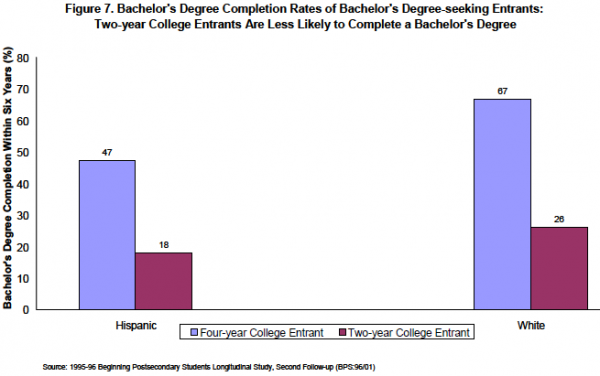The greater success of white youths in entering higher education at four-year colleges rather than two-year colleges will likely boost their educational attainment relative to Hispanic youths. Two-year colleges can provide an appropriate education to meet the aims of some youths. Many youth do not aspire to a bachelor’s degree and aim to attain vocational training or an associate’s degree or certificate. Two-year colleges and non-degree-granting institutions can effectively serve students with basic skill deficiencies and whose high school preparation has not given them the skills they need to succeed in a four-year college (NCES, 2003b). These institutions also often provide educational programs and services that are not offered by four-year colleges.
Nonetheless, freshmen starting on two-year college campuses are much less likely to finish a bachelor’s degree than comparable freshmen on four-year campuses. This applies to all youths regardless of race or ethnicity, and this finding appears quite consistently across national post-secondary education data sets. For example, the U.S. Department of Education tracked the educational progress of a nationally representative sample of students that began their post-secondary education in the 1995-96 academic year (NCES, 2002). The most recent follow-up occurred six years after the students had begun post-secondary education. Analysis of this data reveals that almost half of Hispanic undergraduates who sought a bachelor’s degree and began at a four-year college finished a bachelor’s degree within six years (Figure 7). Fewer than one in five of their counterparts who started at a two-year college finished a bachelor’s degree within six years. The importance of post-secondary starting points for bachelor’s degree completion partly reflects the lesser academic preparation of two-year college entrants vis-à-vis four-year college entrants. However, two-year entrants and four-year entrants with similar high school background and college entrance examination scores have markedly different completion rates.7

One reason for the relatively low bachelor’s completion rates of two-year students is that many two-year students never get to a four-year college or university. Transfer rates from two-year colleges to four-year colleges are fairly low. Tabulations from the 1995-96 Beginning Post-secondary Students Longitudinal survey referred to above indicate that fewer than 45 percent of Hispanic two-year students seeking a bachelor’s degree transferred to a four-year college within six years of entry. But the uphill climb from a two-year college to a bachelor’s degree does not stop with transferring to a four-year institution. Even two-year students who successfully transfer to a four-year college are less likely to earn a bachelor’s degree than students who start at a four-year college. About 44 percent of transfer students finish a bachelor’s degree within six years.8 This compares with a 63 percent graduation rate among students who begin the quest at a four-year college. As Figure 8 shows, differences in high school background do not fully account for the difference in success.

The recent enrollment changes discussed above suggest mixed progress for Latino youth. On the one hand, the proportion of Hispanics enrolling in four-year institutions increased modestly in six states (the exception is Texas). This should provide a boost to the educational attainment of Latino youths by increasing the fraction who complete a bachelor’s degree. In an absolute sense, these changes are favorable for Latino educational advancement. However, in California, New York, New Jersey and Arizona, an even larger additional fraction of white youths enrolled in four-year colleges. Thus, the educational attainment of white youths is likely to receive a greater boost. In a relative sense, therefore, Latino youths are falling further behind their white counterparts in these states.




